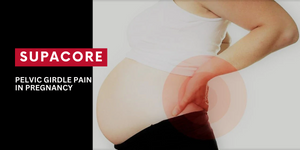PELVIC GIRDLE PAIN IN PREGNANCY –WHAT IS IT AND HOW CAN SUPACORE CORETECH® HELP SUPPORT YOU?
Pelvic Girdle Pain (PGP) is described as pain between the posterior iliac crest and the gluteal fold, particularly in the vicinity of the sacroiliac joint. This pain which may radiate out to the thighs and hips. PGP can occur in conjunction with or separately to pain in the pubic symphysis.
Studies show that 20–25% of all pregnant women suffer from PGP that is serious enough to require medical intervention.5 PGP is not limited to a particular trimester of pregnancy as it is often experienced throughout pregnancy and postpartum; however, the onset most commonly occurs between 14 to 30 weeks’ gestation.2
Many clinicians do not regard PGP as a serious complication of pregnancy 6 however, PGP can interfere with many activities of daily living such us standing, walking, sitting, and all other activities in which the pelvis is involved. Moreover, it can even result in significant physical disability requiring the use of crutches or a wheelchair.6
The amount of pain experienced by women with PGP has corresponding implications. These include extended leave from work during pregnancy, a reduction in the quality of life (as a result of being unable to carry out normal roles, affecting their ability to care for their children) and predisposition to chronic pain syndrome.6,7
The majority of women who experience PGP during pregnancy will recover spontaneously soon after delivery, however about 7% will report persistent PGP that may last for many years.8
The development of PGP in pregnancy is related to hormonal, biomechanical, traumatic, metabolic, genetic and degenerative factors.9 The increase of the hormone relaxin during pregnancy is the main cause of pelvic girdle instability and contributor to PGP.
Women with PGP have increased pelvic, thoracic and lumbar joint mobility, resulting in pelvic instability and pain.11 Lumbopelvic muscle strength and coordination are reduced as a result of altered mechanical forces at the pelvic girdle.10
Treatment:

If you are experiencing Pelvic Girdle Pain we recommend seeing your doctor or physical therapist to help manage your condition.
This may involve modifying your activities, wearing pelvic support garments, physiotherapy and exercise programs to prevent the progression of symptoms.5,11
Compression garments can provide stabilisation of the pelvic girdle and reduce pain and severity of symptoms if fitted correctly and used for the appropriate periods of time.6
A systematic review of the available literature on the use of pregnancy support garments identified that wearing these garments during pregnancy could have beneficial effects such as; pain reduction (lower back pain, PGP), improvement of functionality and mobility, and reduction in the risk of falling during pregnancy.12
Supacore Coretech ® Compression Garments
Supacore Coretech® compression garments incorporate the compression provided by a pelvic belt into shorts and leggings that can be worn during sport, exercise and everyday activities. Pelvic support is provided by applying an external compressive force to the pelvis where it is needed and in the direction it is required. The compressive force mimics the body’s own deep internal stabilising system, in particular the transversus abdominus and the lumbo-sacral multifidus muscles.
The Supacore Coretech® pregnancy garments have an elongated waist which replicate the action of abdominal binders, such as TubigripTM and elasticised abdominal braces.
References:
- Vleeming A, Albert HB, Östgaard HC, Sturesson B, Stuge B. European guidelines for the diagnosis and treatment of pelvic girdle pain. Eur Spine J 2008;17(6):794–819. doi: 10.1007/s00586-008-0602-4.
- Pierce H, Homer CSE, Dahlen HG, King J. Pregnancy-related lumbopelvic pain: Listening to Australian women. Nurs Res Pract 2012;2012:387428. doi: 10.1155/2012/387428.
- Mackenzie J, Murray E, Lusher J. Women’s experiences of pregnancy related pelvic girdle pain: A systematic review. Midwifery 2018;56:102–11. doi: 10.1016/j.midw.2017.10.011.
- Wu WH, Meijer OG, Uegaki K, Mens JM, van Dieën JH, Wuisman PI, Ostgaard HC. Pregnancy-related pelvic girdle pain (PPP), I: Terminology, clinical presentation, and prevalence. Eur Spine J. 2004 Nov;13(7):575-89. doi: 10.1007/s00586-003-0615-y. Epub 2004 Aug 27. PMID: 15338362; PMCID: PMC3476662.
- Homer C, Oats J. Clinical practice guidelines: Pregnancy care. Canberra: Australian Government Department of Health, 2018; p. 355–57.
- Bhardwaj A, Nagandla K. Musculoskeletal symptoms and orthopaedic complications in pregnancy: Pathophysiology, diagnostic approaches and modern management. Postgrad Med J 2014;90(1066):450–60. doi: 10.1136/postgradmedj-2013-132377
- Wu WH, Meijer OG, Bruijn SM, et al. Gait in pregnancy-related pelvic girdle pain: Amplitudes, timing, and coordination of horizontal trunk rotations. Eur Spine J 2008;17(9):1160–69. doi: 10.1007/s00586-008-0703-0.
- Carolina Quintero Rodriguez, Olga Troynikov, "The Effect of Maternity Support Garments on Alleviation of Pains and Discomforts during Pregnancy: A Systematic Review", Journal of Pregnancy, vol. 2019, Article ID 2163790, 21 pages, 2019. https://doi.org/10.1155/2019/2163790

